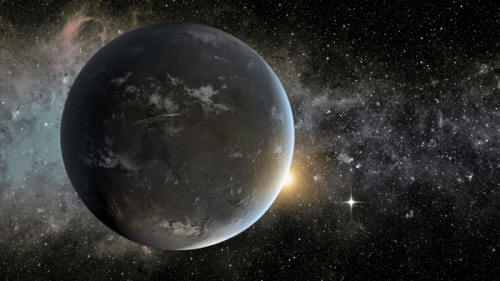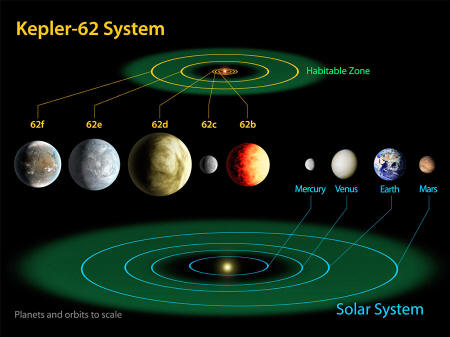|
from
Space Website
The artist's conception depicts Kepler-62f, a super-Earth-size planet in the habitable zone of a star smaller and cooler than the sun, located about 1,200 light-years from Earth in the constellation Lyra.
The small shining
object seen to the right of Kepler-62f is Kepler-62e.
The world is only 1.4 times bigger than Earth and
is in orbit around a star that is somewhat dimmer and smaller than
the sun. It orbits in what is believed to be the habitable region of
its star.
Another notable discovery at the same time was Kepler-62e, which is also close to Earth's size (at 1.6 times the radius) and in the habitable zone.
Separately, a modeling study of Kepler-62e and Kepler-62f suggested that the planets would likely be engulfed in water, which could lead to life that is very different than our own.
This diagram compares the planets of the inner solar system to Kepler-62, a five-planet system about 1,200 light-years from Earth in the constellation Lyra. The five planets of Kepler-62 orbit a star classified as a K2 dwarf,
measuring just two
thirds the size of the sun and only one fifth as bright.
Discovered by space telescope
Kepler-62f was discovered using the Kepler space telescope, an observatory that discovered thousands of exoplanet candidates before it ceased its primary mission in 2013.
(As of late that year, NASA was evaluating new missions for the telescope, which was in an extended mission and now has two malfunctioning reaction wheels originally intended to keep it pointed in the right direction.)
The planet makes a complete circle of its red dwarf star every 267 days and orbits at about the equivalent distance of Venus to the sun in our own solar system. Although this puts the planet far closer to its star than Earth is to the sun, the red dwarf does not produce as much light.
This means that the region around the star where planets could have liquid water is much closer than that of our own solar system.
Kepler-62f, however, is the farthest known planet in its system and may require quite a bit of cloud to insulate the planet and keep water above freezing. If that were the case, water would likely be there in abundance.
Researchers pointed out that life on Earth itself was believed to have started in an aquatic environment.
The key to a more advanced civilization, however, may lie in pockets of dry land.
Technology (as we would understand it, at least) would be difficult to develop unless any alien creatures could work out of the water.
He said a human that somehow found him or herself on the Kepler-62f would have no trouble walking around, as the gravity is gentle.
Breathing, however, would be another matter.
The soupy atmosphere of Kepler-62f could prove difficult for humans to breathe, unless they were to come with special equipment, researchers pointed out.
|



